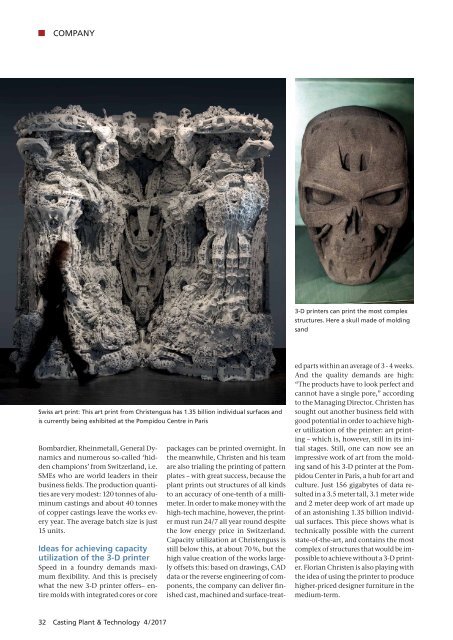CPT International 04/2017
The leading technical journal for the global foundry industry – Das führende Fachmagazin für die weltweite Gießerei-Industrie
The leading technical journal for the
global foundry industry – Das führende Fachmagazin für die
weltweite Gießerei-Industrie
Create successful ePaper yourself
Turn your PDF publications into a flip-book with our unique Google optimized e-Paper software.
COMPANY<br />
3-D printers can print the most complex<br />
structures. Here a skull made of molding<br />
sand<br />
Swiss art print: This art print from Christenguss has 1.35 billion individual surfaces and<br />
is currently being exhibited at the Pompidou Centre in Paris<br />
Bombardier, Rheinmetall, General Dynamics<br />
and numerous so-called ‘hidden<br />
champions’ from Switzerland, i.e.<br />
SMEs who are world leaders in their<br />
business fields. The production quantities<br />
are very modest: 120 tonnes of aluminum<br />
castings and about 40 tonnes<br />
of copper castings leave the works every<br />
year. The average batch size is just<br />
15 units.<br />
Ideas for achieving capacity<br />
utilization of the 3-D printer<br />
Speed in a foundry demands maximum<br />
flexibility. And this is precisely<br />
what the new 3-D printer offers– entire<br />
molds with integrated cores or core<br />
packages can be printed overnight. In<br />
the meanwhile, Christen and his team<br />
are also trialing the printing of pattern<br />
plates – with great success, because the<br />
plant prints out structures of all kinds<br />
to an accuracy of one-tenth of a millimeter.<br />
In order to make money with the<br />
high-tech machine, however, the printer<br />
must run 24/7 all year round despite<br />
the low energy price in Switzerland.<br />
Capacity utilization at Christenguss is<br />
still below this, at about 70 %, but the<br />
high value creation of the works largely<br />
offsets this: based on drawings, CAD<br />
data or the reverse engineering of components,<br />
the company can deliver finished<br />
cast, machined and surface-treated<br />
parts within an average of 3 - 4 weeks.<br />
And the quality demands are high:<br />
“The products have to look perfect and<br />
cannot have a single pore,” according<br />
to the Managing Director. Christen has<br />
sought out another business field with<br />
good potential in order to achieve higher<br />
utilization of the printer: art printing<br />
– which is, however, still in its initial<br />
stages. Still, one can now see an<br />
impressive work of art from the molding<br />
sand of his 3-D printer at the Pompidou<br />
Center in Paris, a hub for art and<br />
culture. Just 156 gigabytes of data resulted<br />
in a 3.5 meter tall, 3.1 meter wide<br />
and 2 meter deep work of art made up<br />
of an astonishing 1.35 billion individual<br />
surfaces. This piece shows what is<br />
technically possible with the current<br />
state-of-the-art, and contains the most<br />
complex of structures that would be impossible<br />
to achieve without a 3-D printer.<br />
Florian Christen is also playing with<br />
the idea of using the printer to produce<br />
higher-priced designer furniture in the<br />
medium-term.<br />
32 Casting Plant & Technology 4 / <strong>2017</strong>


















